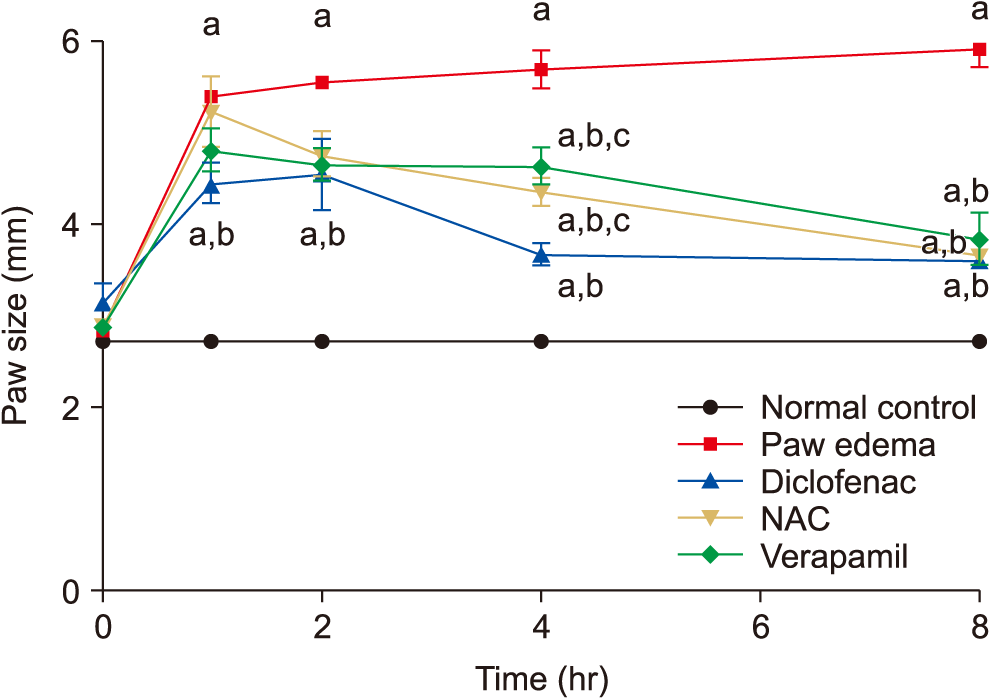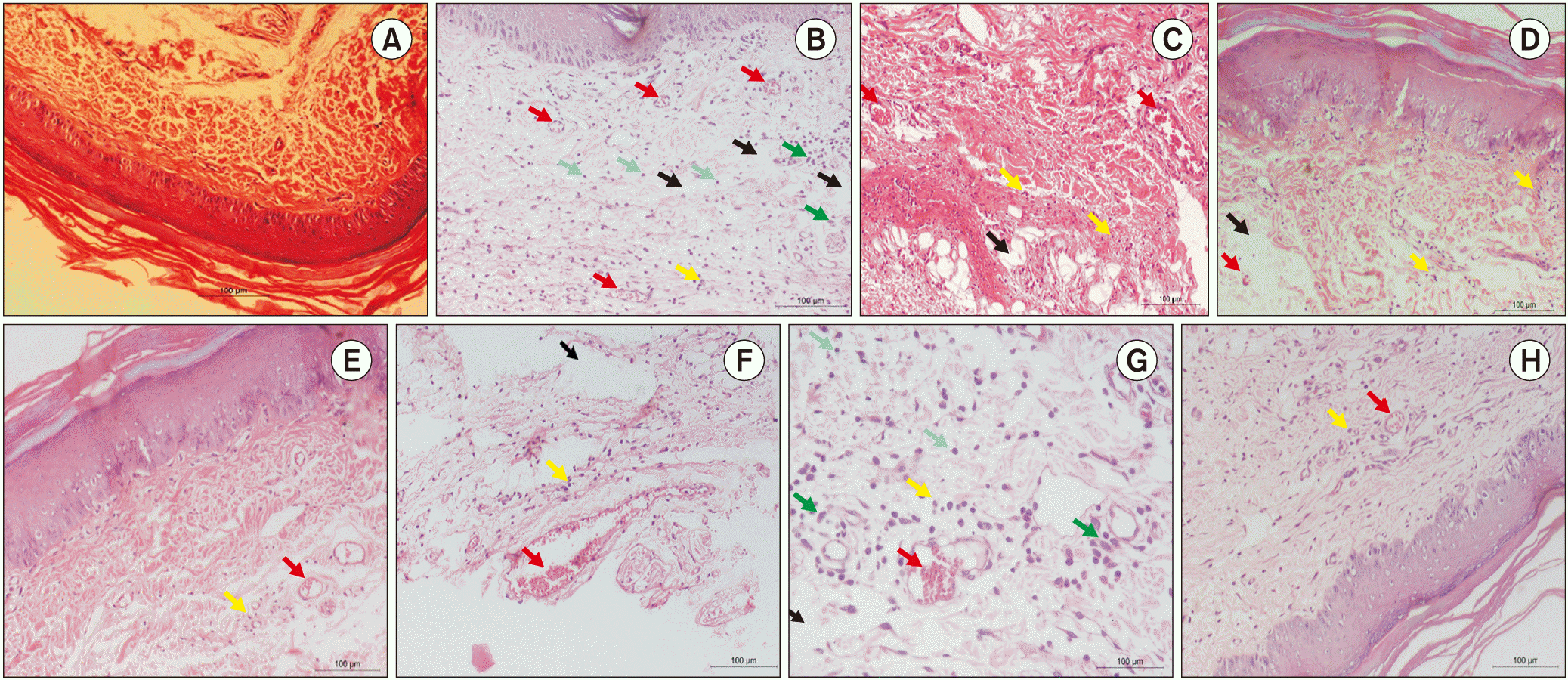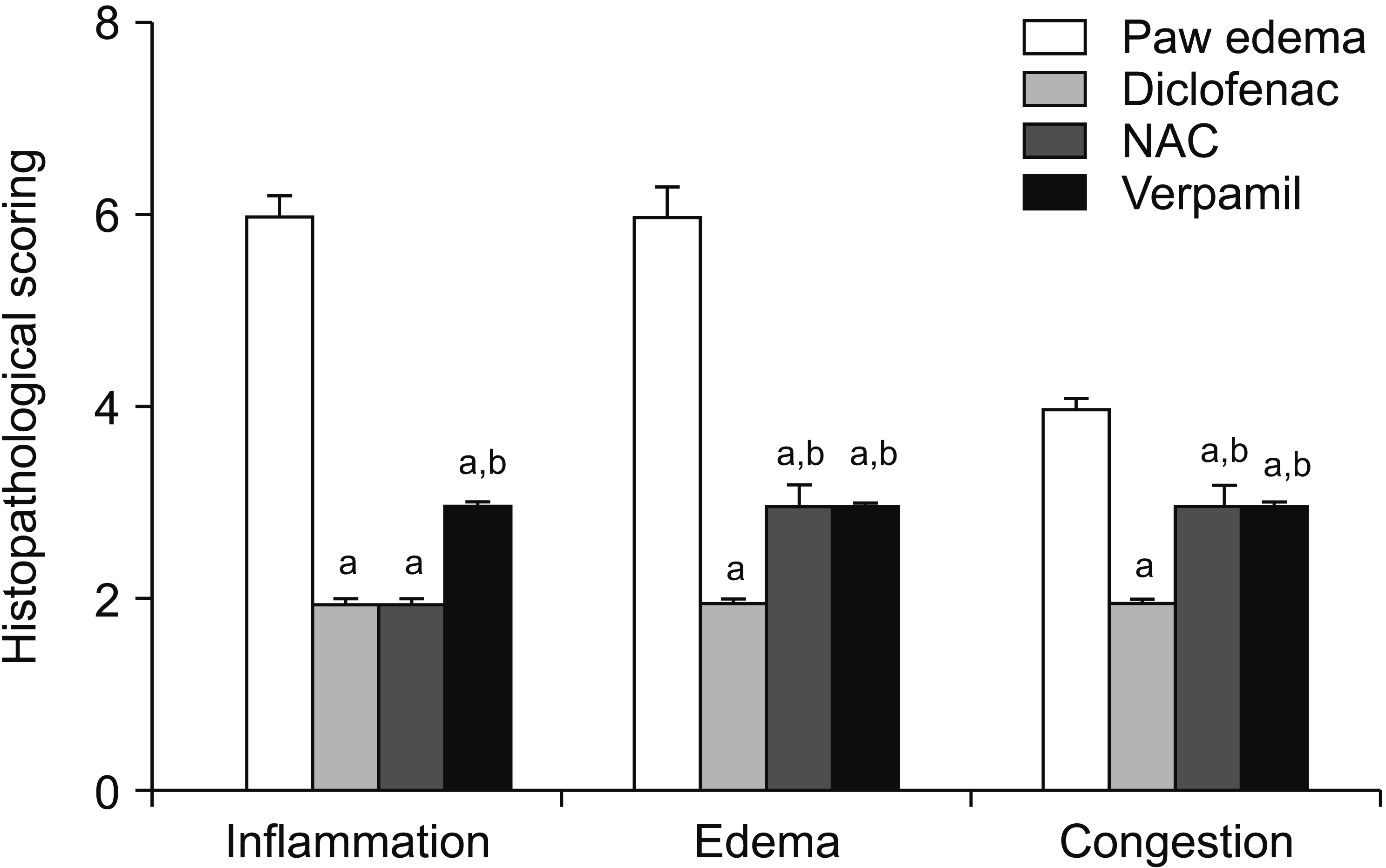1. Swarup A, Agarwal R, Malhotra S, Dube AS. A comparative study of efficacy of gabapentin in inflammation induced neuropathic animal pain models with conventional analgesic diclofenac. Int J Res Med Sci. 2016; 4:1429–32. DOI:
10.18203/2320-6012.ijrms20161204.

2. Trevisan G, Benemei S, Materazzi S, De Logu F, De Siena G, Fusi C, et al. TRPA1 mediates trigeminal neuropathic pain in mice downstream of monocytes/macrophages and oxidative stress. Brain. 2016; 139:1361–77. DOI:
10.1093/brain/aww038. PMID:
26984186.

3. Hasanvand A, Ahmadizar F, Abbaszadeh A, Amini-Khoei H, Goudarzi M, Abbasnezhad A, et al. The antinociceptive effects of rosuvastatin in chronic constriction injury model of male rats. Basic Clin Neurosci. 2018; 9:251–60. DOI:
10.32598/bcn.9.4.251. PMID:
30519383. PMCID:
PMC6276538.

4. Howard L. Fields. Pain free: modern drugs and neuropathic pain. J Korean Med Sci. 2002; 22:360–7.
5. McGettigan P, Henry D. Use of non-steroidal anti-inflammatory drugs that elevate cardiovascular risk: an examination of sales and essential medicines lists in low-, middle-, and high-income countries. PLoS Med. 2013; 10:e1001388. DOI:
10.1371/journal.pmed.1001388. PMID:
23424288. PMCID:
PMC3570554.

7. Triggle DJ. Calcium-channel drugs: structure-function relationships and selectivity of action. J Cardiovasc Pharmacol. 1991; 18(Suppl 10):S1–6. DOI:
10.1097/00005344-199118101-00002. PMID:
1724996.
8. Hotchkiss RS, Bowling WM, Karl IE, Osborne DF, Flye MW. Calcium antagonists inhibit oxidative burst and nitrite formation in lipopolysaccharide-stimulated rat peritoneal macrophages. Shock. 1997; 8:170–8. DOI:
10.1097/00024382-199709000-00004. PMID:
9377163.

9. Liu Y, Lo YC, Qian L, Crews FT, Wilson B, Chen HL, et al. Verapamil protects dopaminergic neuron damage through a novel anti-inflammatory mechanism by inhibition of microglial activation. Neuropharmacology. 2011; 60:373–80. DOI:
10.1016/j.neuropharm.2010.10.002. PMID:
20950631. PMCID:
PMC3014428.

10. Kalonia H, Kumar P, Kumar A. Attenuation of proinflammatory cytokines and apoptotic process by verapamil and diltiazem against quinolinic acid induced Huntington like alterations in rats. Brain Res. 2011; 1372:115–26. DOI:
10.1016/j.brainres.2010.11.060. PMID:
21112316.

11. Eteraf-Oskouei T, Mikaily MS, Najafi M. Anti-inflammatory and anti-angiogenesis effects of verapamil on rat air pouch inflammation model. Adv Pharm Bull. 2017; 7:585–91. DOI:
10.15171/apb.2017.070. PMID:
29399548. PMCID:
PMC5788213.

13. Yuan J, Ma H, Cen N, Zhou A, Tao H. A pharmacokinetic study of diclofenac sodium in rats. Biomed Rep. 2017; 7:179–82. PMID:
28781777. PMCID:
PMC5526189.

14. Horst A, de Souza JA, Santos MCQ, Riffel APK, Kolberg C, Partata WA. Effects of N-acetylcysteine on spinal cord oxidative stress biomarkers in rats with neuropathic pain. Braz J Med Biol Res. 2017; 50:e6533. DOI:
10.1590/1414-431x20176533. PMID:
29069230. PMCID:
PMC5649872.

15. Tamaddonfard E, Erfanparast A, Taati M, Dabbaghi M. Role of opioid system in verapamil-induced antinociception in a rat model of orofacial pain. Vet Res Forum. 2014; 5:49–54. PMID:
25568692. PMCID:
PMC4279656.
16. Langerman L, Zakowski MI, Piskoun B, Grant GJ. Hot plate versus tail flick: evaluation of acute tolerance to continuous morphine infusion in the rat model. J Pharmacol Toxicol Methods. 1995; 34:23–7. DOI:
10.1016/1056-8719(94)00077-H. PMID:
7496043.

18. Vittalrao AM, Shanbhag T, Kumari M, Bairy KL, Shenoy S. Evaluation of antiinflammatory and analgesic activities of alcoholic extract of Kaempferia galanga in rats. Indian J Physiol Pharmacol. 2011; 55:13–24. PMID:
22315806.
19. Yoon MH, Choi JI. Pharmacologic interaction between cannabinoid and either clonidine or neostigmine in the rat formalin test. Anesthesiology. 2003; 99:701–7. DOI:
10.1097/00000542-200309000-00027. PMID:
12960556.

20. Van Herck H, Baumans V, Brandt CJ, Hesp AP, Sturkenboom JH, van Lith HA, et al. Orbital sinus blood sampling in rats as performed by different animal technicians: the influence of technique and expertise. Lab Anim. 1998; 32:377–86. DOI:
10.1258/002367798780599794. PMID:
9807751.

21. Yamamoto-Fukud T, Shibata Y, Hishikawa Y, Shin M, Yamaguchi A, Kobayashi T, et al. Effects of various decalcification protocols on detection of DNA strand breaks by terminal dUTP nick end labelling. Histochem J. 2000; 32:697–702. DOI:
10.1023/A:1004171517639. PMID:
11272810.
22. Giglio CA, Defino HL, da-Silva CA, de-Souza AS, Del Bel EA. Behavioral and physiological methods for early quantitative assessment of spinal cord injury and prognosis in rats. Braz J Med Biol Res. 2006; 39:1613–23. DOI:
10.1590/S0100-879X2006001200013. PMID:
17160271.

23. Horst A, Kolberg C, Moraes MS, Riffel AP, Finamor IA, Belló-Klein A, et al. Effect of N-acetylcysteine on the spinal-cord glutathione system and nitric-oxide metabolites in rats with neuropathic pain. Neurosci Lett. 2014; 569:163–8. DOI:
10.1016/j.neulet.2014.03.063. PMID:
24704379.

24. Abdollahi M, Nikfar S, Abdoli N. Potentiation by nitric oxide synthase inhibitor and calcium channel blocker of aspartame-induced antinociception in the mouse formalin test. Fundam Clin Pharmacol. 2001; 15:117–23. DOI:
10.1046/j.1472-8206.2001.00013.x. PMID:
11468021.

26. Damas J, Liégeois JF. The inflammatory reaction induced by formalin in the rat paw. Naunyn Schmiedebergs Arch Pharmacol. 1999; 359:220–7. DOI:
10.1007/PL00005345. PMID:
10208309.

27. Lasram MM, Lamine AJ, Dhouib IB, Bouzid K, Annabi A, Belhadjhmida N, et al. Antioxidant and anti-inflammatory effects of N-acetylcysteine against malathion-induced liver damages and immunotoxicity in rats. Life Sci. 2014; 107:50–8. DOI:
10.1016/j.lfs.2014.04.033. PMID:
24810974.

28. Farshid AA, Tamaddonfard E, Yahyaee F. Effects of histidine and N-acetylcysteine on diclofenac-induced anti-inflammatory response in acute inflammation in rats. Indian J Exp Biol. 2010; 48:1136–42. PMID:
21117455.
29. Martinez LL, Aparecida De Oliveira M, Fortes ZB. Influence of verapamil and diclofenac on leukocyte migration in rats. Hypertension. 1999; 34:997–1001. DOI:
10.1161/01.HYP.34.4.997. PMID:
10523397.

30. Berk M, Malhi GS, Gray LJ, Dean OM. The promise of N-acetylcysteine in neuropsychiatry. Trends Pharmacol Sci. 2013; 34:167–77. DOI:
10.1016/j.tips.2013.01.001. PMID:
23369637.

31. Pireddu R, Caddeo C, Valenti D, Marongiu F, Scano A, Ennas G, et al. Diclofenac acid nanocrystals as an effective strategy to reduce in vivo skin inflammation by improving dermal drug bioavailability. Colloids Surf B Biointerfaces. 2016; 143:64–70. DOI:
10.1016/j.colsurfb.2016.03.026. PMID:
26998867.

32. Messiha BA, Abo-Youssef AM. Protective effects of fish oil, allopurinol, and verapamil on hepatic ischemia-reperfusion injury in rats. J Nat Sci Biol Med. 2015; 6:351–5. DOI:
10.4103/0976-9668.160003. PMID:
26283828. PMCID:
PMC4518408.

33. Ray SD, Kamendulis LM, Gurule MW, Yorkin RD, Corcoran GB. Ca2+ antagonists inhibit DNA fragmentation and toxic cell death induced by acetaminophen. FASEB J. 1993; 7:453–63. DOI:
10.1096/fasebj.7.5.8462787. PMID:
8462787.
34. Huang FM, Chou LS, Chou MY, Chang YC. Protective effect of NAC on formaldehyde-containing-ZOE-based root-canalsealers-induced cyclooxygenase-2 expression and cytotoxicity in human osteoblastic cells. J Biomed Mater Res B Appl Biomater. 2005; 74:768–73. DOI:
10.1002/jbm.b.30283. PMID:
15934011.

35. Wang W, Li Z, Meng Q, Zhang P, Yan P, Zhang Z, et al. Chronic calcium channel inhibitor verapamil antagonizes TNF-α-mediated inflammatory reaction and protects against inflammatory arthritis in mice. Inflammation. 2016; 39:1624–34. DOI:
10.1007/s10753-016-0396-1. PMID:
27438468.

36. Kusama K, Yoshie M, Tamura K, Imakawa K, Isaka K, Tachikawa E. Regulatory action of calcium ion on cyclic AMP-enhanced expression of implantation-related factors in human endometrial cells. PLoS One. 2015; 10:e0132017. DOI:
10.1371/journal.pone.0132017. PMID:
26161798. PMCID:
PMC4498924.

38. Pathak S, Stern C, Vambutas A. N-Acetylcysteine attenuates tumor necrosis factor alpha levels in autoimmune inner ear disease patients. Immunol Res. 2015; 63:236–45. DOI:
10.1007/s12026-015-8696-3. PMID:
26392121. PMCID:
PMC4651738.

39. Talasaz AH, Khalili H, Jenab Y, Salarifar M, Broumand MA, Darabi F. N-Acetylcysteine effects on transforming growth factor-β and tumor necrosis factor-α serum levels as profibrotic and inflammatory biomarkers in patients following ST-segment elevation myocardial infarction. Drugs R D. 2013; 13:199–205. DOI:
10.1007/s40268-013-0025-5. PMID:
24048773. PMCID:
PMC3784054.

40. Park JH, Kang SS, Kim JY, Tchah H. The antioxidant N-acetylcysteine inhibits inflammatory and apoptotic processes in human conjunctival epithelial cells in a high-glucose environment. Invest Ophthalmol Vis Sci. 2015; 56:5614–21. DOI:
10.1167/iovs.15-16909. PMID:
26305534.

41. Li G, Qi XP, Wu XY, Liu FK, Xu Z, Chen C, et al. Verapamil modulates LPS-induced cytokine production via inhibition of NF-kappa B activation in the liver. Inflamm Res. 2006; 55:108–13. DOI:
10.1007/s00011-005-0060-y. PMID:
16673153.

42. Guibas GV, Spandou E, Meditskou S, Vyzantiadis TA, Priftis KN, Anogianakis G. N-acetylcysteine exerts therapeutic action in a rat model of allergic rhinitis. Int Forum Allergy Rhinol. 2013; 3:543–9. DOI:
10.1002/alr.21145. PMID:
23307410.

43. Bergamini S, Rota C, Canali R, Staffieri M, Daneri F, Bini A, et al. N-acetylcysteine inhibits in vivo nitric oxide production by inducible nitric oxide synthase. Nitric Oxide. 2001; 5:349–60. DOI:
10.1006/niox.2001.0356. PMID:
11485373.

44. Saddadi F, Alatab S, Pasha F, Ganji MR, Soleimanian T. The effect of treatment with N-acetylcysteine on the serum levels of C-reactive protein and interleukin-6 in patients on hemodialysis. Saudi J Kidney Dis Transpl. 2014; 25:66–72. DOI:
10.4103/1319-2442.124489. PMID:
24434384.

45. Nascimento MM, Suliman ME, Silva M, Chinaglia T, Marchioro J, Hayashi SY, et al. Effect of oral N-acetylcysteine treatment on plasma inf lammatory and oxidative stress markers in peritoneal dialysis patients: a placebo-controlled study. Perit Dial Int. 2010; 30:336–42. DOI:
10.3747/pdi.2009.00073. PMID:
20190028.

48. Bleier BS, Kocharyan A, Singleton A, Han X. Verapamil modulates interleukin-5 and interleukin-6 secretion in organotypic human sinonasal polyp explants. Int Forum Allergy Rhinol. 2015; 5:10–3. DOI:
10.1002/alr.21436. PMID:
25330767.









 PDF
PDF Citation
Citation Print
Print


 XML Download
XML Download